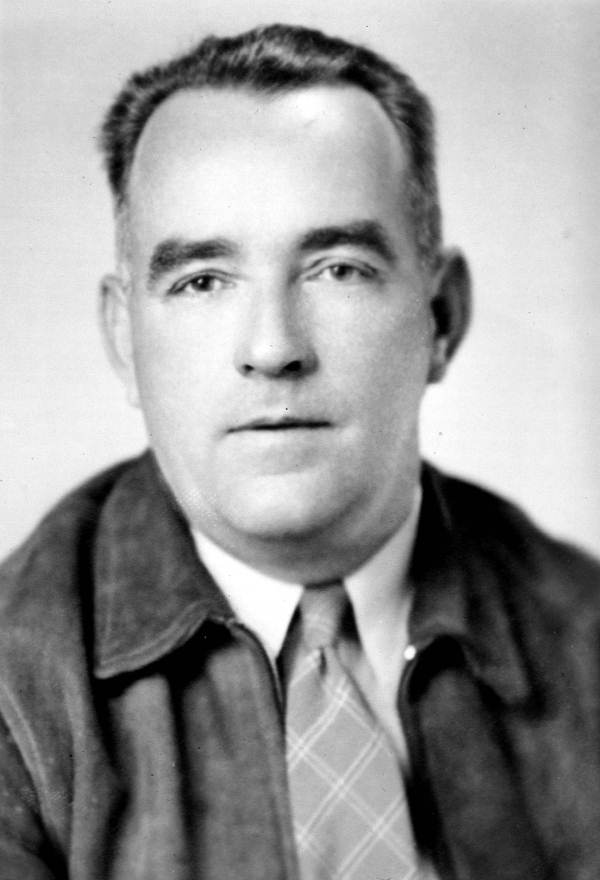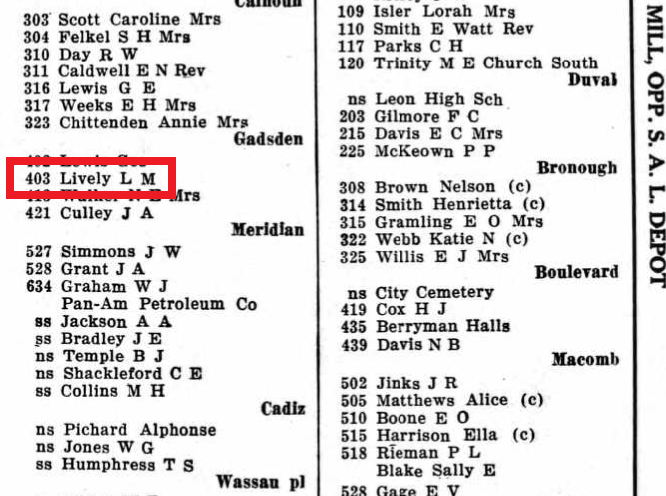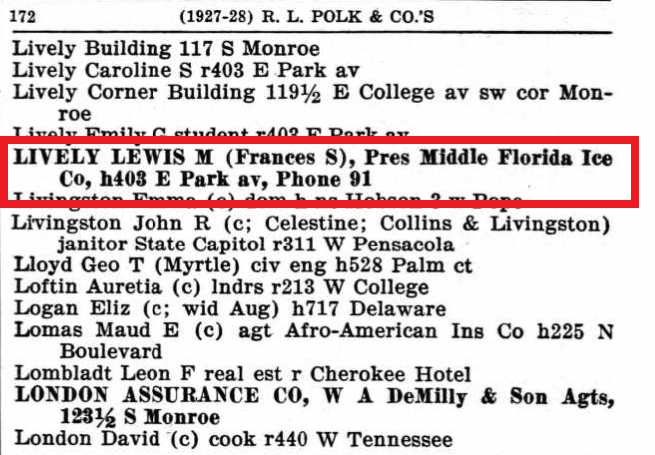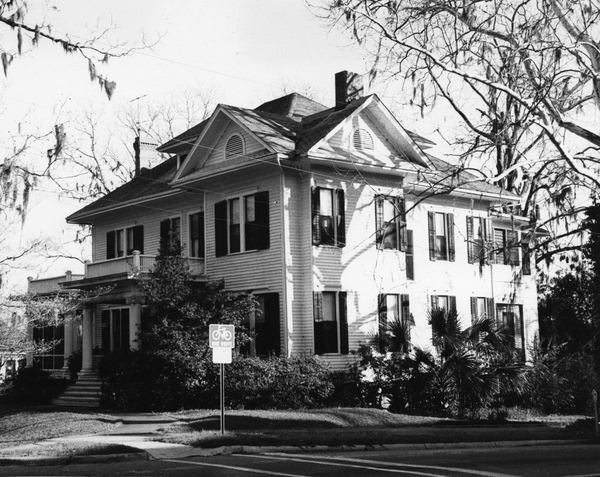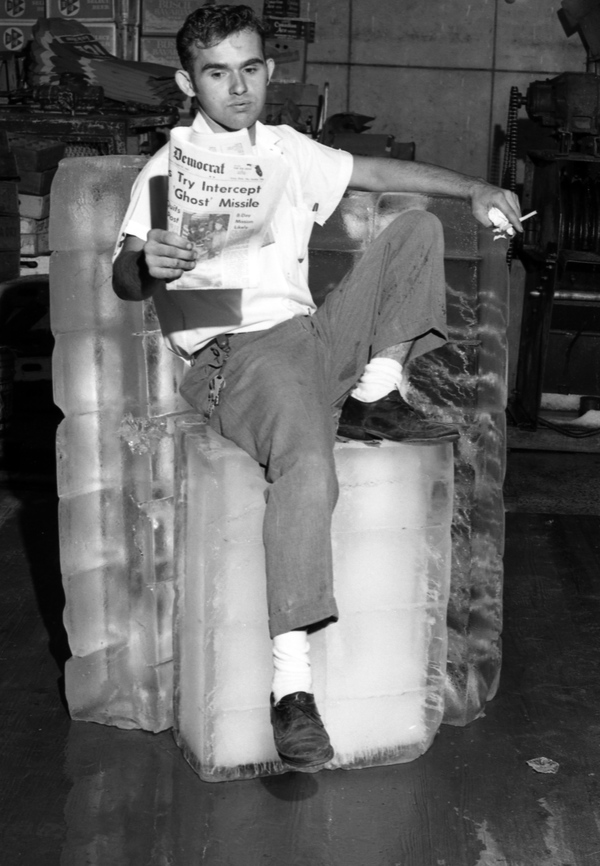Description of previous item
Description of next item
It's in the Directory
Published December 12, 2015 by Florida Memory
Remember back before the Internet when you needed the “phone book” to find a phone number or address for a person or business? These days, we tend to use printed directories for booster seats and doorstops more than for their intended purpose, but these volumes do have a critical role to play as a historical resource. Especially the older ones.

A few of the published city directories available at the State Library of Florida – others are available on microfilm or through online databases like Ancestry.com.
For many Florida municipalities, city directories have been published annually for over a century. The content in each volume varies by town, year, and publisher, but generally they include an alphabetical list of residents with addresses, a classified business directory, information about local officials, clubs, public services, and societies, and a street guide. Some directories also include information on nearby towns too small to have their own published directories.
City directories are a goldmine for genealogists, because they can potentially provide several kinds of information about an individual:
- Where the person lived
- The person’s occupation
- The names of persons living in the same home (including spouse) or neighborhood
- Who lived at the same address before someone moved in
- Where the person moved to/from (if in the same city)
- How long a person lived in a particular city
These volumes are also useful for local historians because they can help with tracing the history of a particular building, a business, a club or society, or other local entity.
City directories may be found in public libraries, the State Library of Florida, or through one of a number of online databases. Ancestry.com provides searchable digitized editions of many Florida city directories, and a number of Florida cities have completed their own digitization projects to make the directories available online.
So how do you use these city directories for family history research? Let’s make an example of this gentleman whose portrait is included in the Florida Photographic Collection:
The catalog record for this portrait of Leonard A. Wesson says it was taken in Tallahassee in 1940. That’s all we know at this point. Using city directories, however, we can determine whether he actually resided in Tallahassee, and if he did we can determine roughly how long he lived there. We can also find out his occupation, whether he was married, and whether he moved around a bit while he was in the area. Let’s start out by checking the alphabetical name index in the 1940 Tallahassee city directory:
And there he is! From this entry, we see that Leonard had a wife named Winifred, and that the two of them were living at 503 E. McDaniel St. in Tallahassee in 1940. We also see that Mr. Wesson was a busy fellow, serving as Secretary to both the Middle Florida Ice Company and the Tallahassee Coca-Cola Bottling Company. This is good information, but it’s only a start. How long did Leonard and Winifred live at this location? Who lived in this house before they did? Was Leonard Wesson always associated with the two companies he was working for in 1940?
To find the answers, let’s back up a few years to 1936. We’ll start out by looking at the alphabetical name index once again:
This entry turns up some interesting information. It appears Leonard Wesson was serving as mayor of Tallahassee in 1936. He was living at the same location as he would four years later in 1940, and we get to see his telephone number in this directory. Note that Winifred’s middle initial is listed here as “A” rather than “L” as it appeared in 1940. One is probably her given middle initial and the other the initial for her maiden surname. This information could come in handy later when searching for Winifred in an index.
Let’s keep going backward in time to see what else we can learn about Leonard and Winifred. Here is their alphabetical index entry for 1930:
Intriguing… Leonard Wesson was working as a civil engineer in 1930, and living with Winifred in a completely different location, 403 E. Park Avenue. Also, we can tell that the Wessons didn’t own the house, because the address is preceded by an “R” for “roomer” or “resident” rather than an “H” for “householder.” Each directory explains its use of abbreviations at the beginning of the alphabetical name index.
If you’re wondering who was living at the Wessons’ future home on McDaniel Street at that time, there’s an easy way to find out. Most city directories have a reverse lookup street guide that allows you to determine who was living in each building along a particular city street. So, to see who was living at 503 E. McDaniel Street in Tallahassee in 1930, we need to look at McDaniel Street in the street guide. Here’s the page:
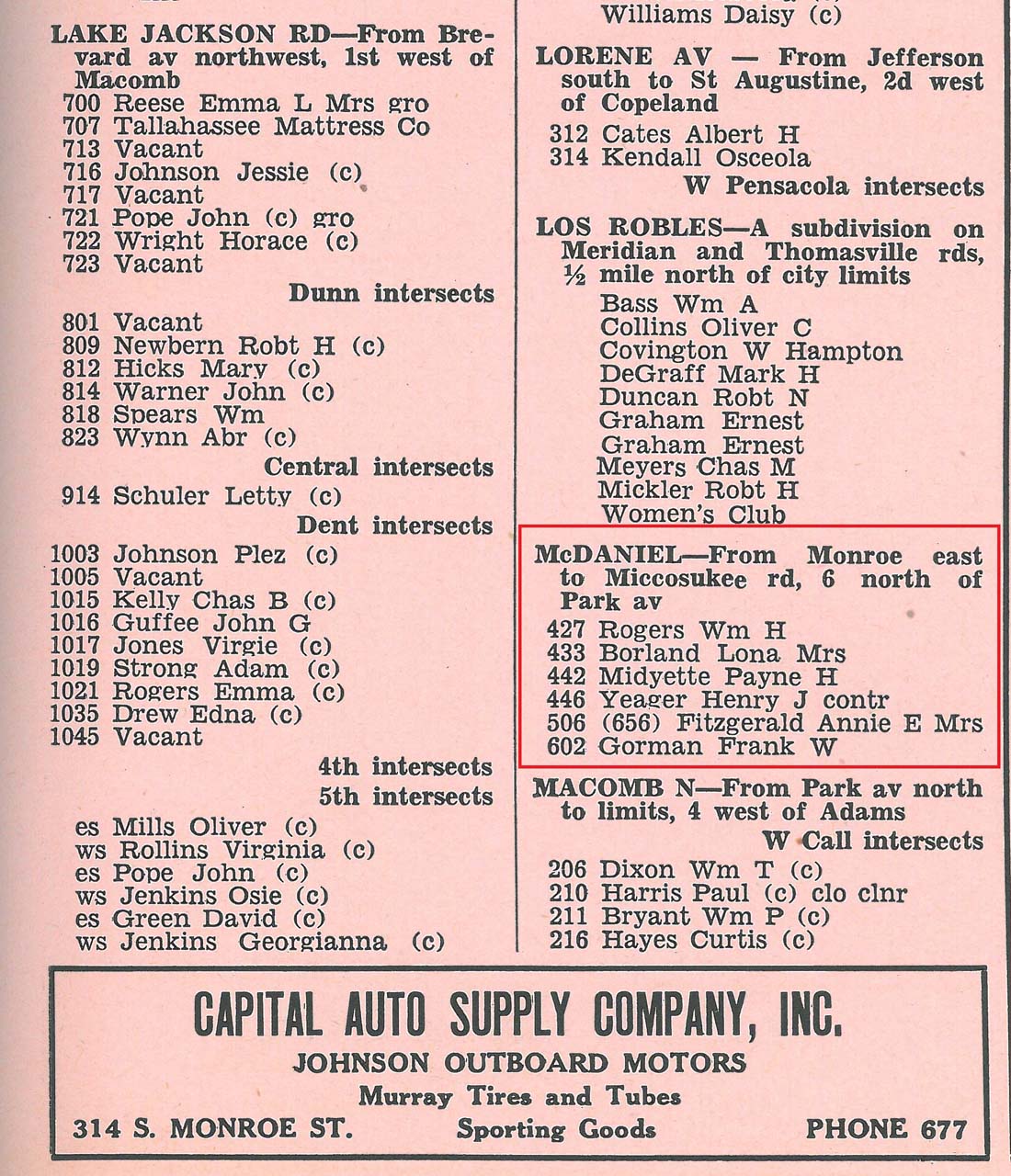
An excerpt of a page from the reverse lookup street guide included in the 1930 Polk’s City Directory for Tallahassee.
Notice that the address 503 E. McDaniel Street does not appear at all in the listing. Since this directory shows when a house was vacant (e.g. 1045 Lake Jackson Rd. in the excerpt above), we can safely assume this means the Wessons’ house had not yet been completed when the directory was published. (Note: A little extra research confirmed that the Lafayette Park neighborhood where the Wessons relocated in the 1930s was indeed undergoing development at this time.)
To determine how long Leonard and Winifred lived at 403 E. Park Avenue or elsewhere in Tallahassee, we could continue following them through various city directories, but let’s try to find out who lived at their home on Park Avenue before they began rooming there. To do this, we simply look up that address in the reverse lookup street guide for previous years until we find a different occupant listed. Let’s try the 1927 directory for Tallahassee:
L.M. Lively shows up as the primary householder for 403 E. Park Avenue in 1927. That’s helpful to know, but who is L.M. Lively? We can find out more about him by looking him up in the alphabetical name index in the same 1927 volume:
Interesting! The resident of 403 E. Park Avenue in 1927 was Lewis M. Lively, president of the Middle Florida Ice Company, which Leonard Wesson would later work for. We see from the address listing that Lively owned the house, which suggests that he was likely the person who rented it to Wesson and his wife Winifred in the 1930s.
From these bits of information, a clearer picture of Leonard Wesson begins to emerge. In the late 1920s, he was a civil engineer in Tallahassee, possibly working for Lewis M. Lively at the Middle Florida Ice Company. By 1940, Wesson had moved up the ladder, had served as mayor of Tallahassee, and had become secretary to Middle Florida Ice. He had also built a house in the new Lafayette Park neighborhood. Armed with these details, we can now begin cross-referencing the information with other sources to help build a more detailed profile of Leonard Wesson’s life. A quick search of the Florida Photographic Collection, for example, reveals that photos exist of the Lively house at 403 E. Park Avenue:
This is just one example of the many life stories that city directories can help reconstruct. Visit your local library, the State Library of Florida, or an online database to explore city directories and see what you can discover!
Need help finding a specific city directory? Contact the State Library’s reference desk by phone at (850)-245-6682 or email at library@dos.myflorida.com for assistance.
Cite This Article
Chicago Manual of Style
(17th Edition)Florida Memory. "It's in the Directory." Floridiana, 2015. https://www.floridamemory.com/items/show/321962.
MLA
(9th Edition)Florida Memory. "It's in the Directory." Floridiana, 2015, https://www.floridamemory.com/items/show/321962. Accessed December 23, 2025.
APA
(7th Edition)Florida Memory. (2015, December 12). It's in the Directory. Floridiana. Retrieved from https://www.floridamemory.com/items/show/321962

 Listen: The Bluegrass & Old-Time Program
Listen: The Bluegrass & Old-Time Program